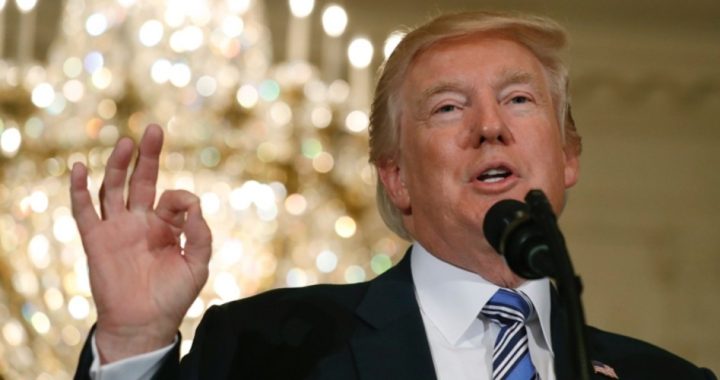
Speaking with members of the press aboard Air Force One on July 13, President Trump shared some of his ideas for the construction of the wall along the Mexican border — a proposal that had been a major part of his 2016 presidential campaign.
Among the ideas he discussed was having openings in the wall so that border agents on the U.S. side of the wall could see what was immediately on the other side.
“One of the things with the wall is you need transparency. You have to be able to see through it,” said the president. “So it could be a steel wall with openings, but you have to have openings because you have to see what’s on the other side of the wall.”
Trump went on to explain his reasons for being able to see though the wall:
“As horrible as it sounds, when they throw the large sacks of drugs over, and if you have people on the other side of the wall, you don’t see them — they hit you on the head with 60 pounds of stuff? It’s over. As crazy as that sounds, you need transparency through that wall.”
“We have some incredible designs,” Trump added.
Another idea Trump discussed was the concept of placing solar panels atop the wall — an idea that some observers at first thought was meant as a joke. However, he made it clear that his proposal was a serious one. “No, not joking, no. There is a chance that we can do a solar wall,” Trump said. “We have major companies looking at that. Look, there’s no better place for solar than the Mexico border — the southern border. And there is a very good chance we can do a solar wall, which would actually look good.”
An article in the Washington Post on June 27 cited statements made by Ronald Vitiello, the U.S. Customs and Border Protection’s acting deputy commissioner, that his agency plans to select four to eight firms in the coming weeks to build the prototypes for the president much-discussed border wall. The Post reported that the prototypes — including a reinforced concrete barrier wall and another made of an alternative material with see-through capability — will be built in San Diego.
The report cited a statement made by Trump the prior week that his wall would pay for itself if it were made of solar panels. “This way, Mexico will have to pay much less money,” Trump said during a rally in Cedar Rapids, Iowa. “A solar wall. It makes sense. Let’s see. We are working it out. Solar wall panels.” The reference to Mexico paying less money addressed the president’s continuous statements that he would make Mexico pay for the wall.
But does a “solar wall” make sense, as President Trump claims?
An article in Business Insider on July 13 claimed that a solar border wall would generate approximately 7.28 gigawatt-hours (GWh) of electricity each day (2,657.2 GWh per year) and power 220,000 average-size homes annually, according to one solar installation firm. Other estimates reach as high as 8,431 GWh annually, said the report. The dollar value of this electrical generation would be approximately $106 million per year. The article named the Oregon-based solar installation firm Elemental Energy as the source of the estimates regarding the electrical generating potential of a solar border wall. Elemental’s co-owner, John Grieser, who produced these estimates, told Business Insider: “I don’t support a wall, but if it has to be built, and it’s completely out of my control and influence, then we might as well put some solar panels on it.”
However, such claims notwithstanding, if large-scale solar power generation made good economic sense, then there should be more solar-generation plants being built — without government assistance!
An obvous drawback with solar power is that the power can only be generated when the sun is out. But there is another problem, which has to do with the amount of energy reaching the Earth from the sun for any given area. As energy expert Ed Hiserodt explained in a 2010 article for The New American: “The peak insolation (solar energy striking a surface — in this case, Earth) used for calculating peak power outputs from solar power is considered to be 1,000 watts per square meter. (This number represents a theoretical insolation; it cannot actually be found on Earth.) From this we see it takes about 1,000 square meters (10,000 square feet) of mirrors to produce one megawatt of electrical energy. A 100 MW solar power plant (one-tenth the capacity of a typical nuclear plant) using mirrors that are 10-feet ‘tall’ would then require 100,000 linear feet of parabolic trough — just shy of 19 miles.” Because of the drawbacks, it is not surprising solar-power advocates would also support government subsidies of the projects — including, in this case, converting a border wall into a border solar wall.
Photo of President Trump: AP Images
Related articles:
Trump Signs Executive Orders to Build Border Wall and Strengthen Immigration Enforcement
Trump Criticizes Media and Says Mexico Will Pay Back U.S. for Border Wall
Trump Transition Immigration Advisor: Wall Will Be Built
Ex-Mexican Official: Trump Can Make Mexico Pay for Wall, Si!



